Here in KwaZulu-Natal the winters are dry. The wild grasslands are golden but are brightened by wild flowers, and the remnants of woodland and forest have their flowering trees too, some of which we are fortunate to have in our garden.
These photographs were all taken in our garden during June and July. Most of the flowers are orange, and so particularly cheerful and warming. They provide sustenance to a variety of birds and other creatures during the tough winter months.
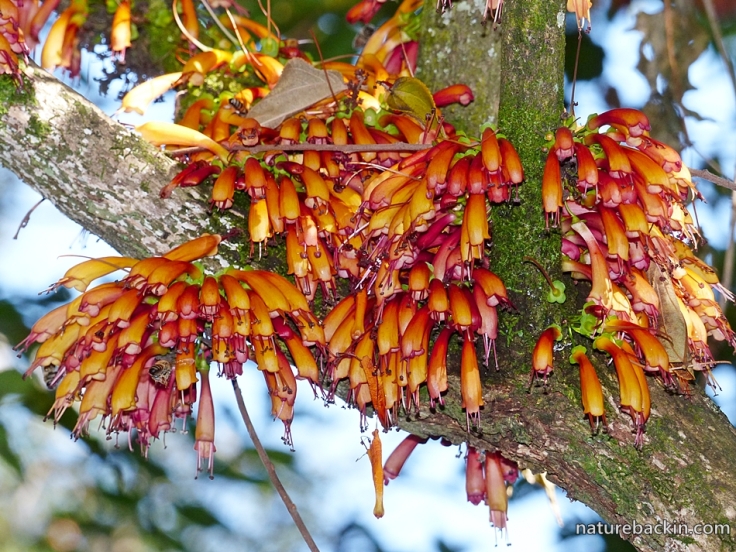
A representative of the forests and the forest margins is the Tree Fuschia (Halleria lucida). Its intriguing flowers grow in clusters directly from the stem. I have posted on this tree before, but could not resist showcasing it again. At this time of the year it is alive with the buzzing of bees attracted to the flowers and it is also visited by sunbirds, bulbuls, whiteyes and other birds, as well as by Vervet monkeys

Also of the forests and woodlands but of the understorey, is the low-growing shade-loving White Paint Brush (Haemanthus albiflos). Its flowers with their showy stamens also attracts many bees
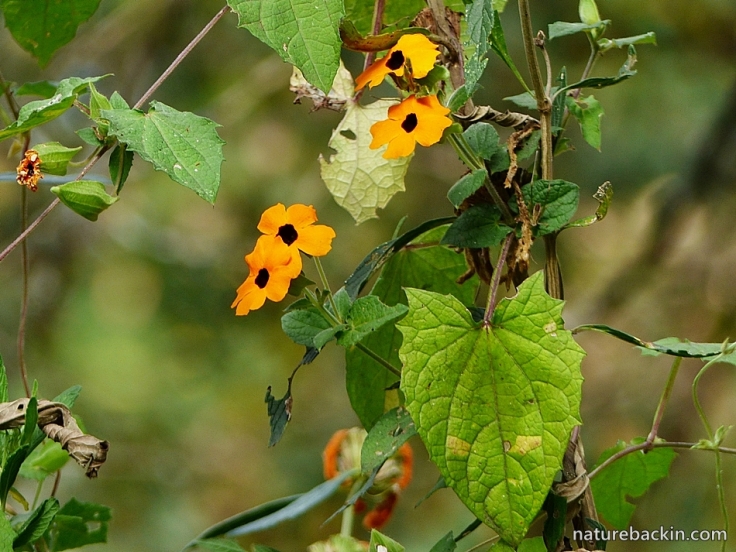
Also growing on the forest margins is the ultra-cheerful Black-eyed Susan (Thunbergia alata), a tenacious little creeper than can climb several metres high in supporting vegetation

An early harbinger of spring is the Natal Bottlebrush (Greyia Sutherlandii), which is putting forth flower buds even before the winter leaves have fallen and long before the new leaves of spring. It is a small tree with a rather gnarled appearance and it grows naturally in mountainous terrain
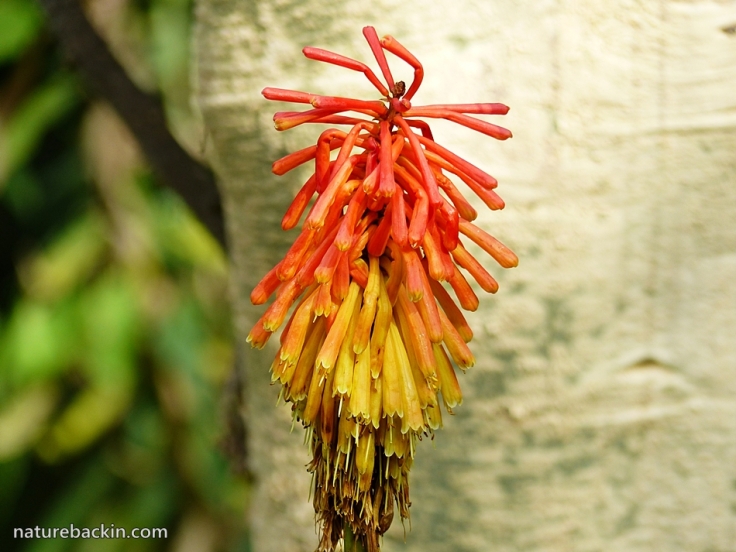
And here is a winter-flowering Kniphofia – a newish addition to our garden, photographed with the pale yellow bark of a Fever tree behind it. Unfortunately, I can’t find my notes on which Kniphofia (known as Red-hot Pokers) it is. (It might be Kniphofia praecox?) What I do recall though is that the genus is named after J.H. Kniphof (1704-1763), a professor of medicine at Erfurt University. Therefore, the name ought to be pronounced Knip-Hofia (with a hard ‘K’), rather than “Nif-Fofia” as is commonly the case. Not sure that this will catch on though,

Though not orange, the flowers of the Ribbon Bush (Hypoestes aristata) are nevertheless cheerful. The shrubby and hardy Ribbon Bush flowers indefatigably from autumn through to late winter. Its flowers are favoured by bees and other pollinators. You might be able to see how the pollen collected by the bee in the photo is purple

Another cheerful and hardy favourite is the Wild Dagga (Leonotus leonurus), which occurs naturally in grassland habitats. It is frequently visited by sunbirds while flowering. I leave the tall flower spikes to go to seed and it self-seeds readily. I gather up the seedlings in the spring to transplant or to put in pots to give away to friends

And on the subject of seeds, is this not an attractive seedpod? Not a flower I know, but it is most decorative. It is the pod of the Dwarf Boer-bean (Schotia capitata). When ripe, the woody pod splits to reveal the seeds, which appear to be relished by Vervet monkeys
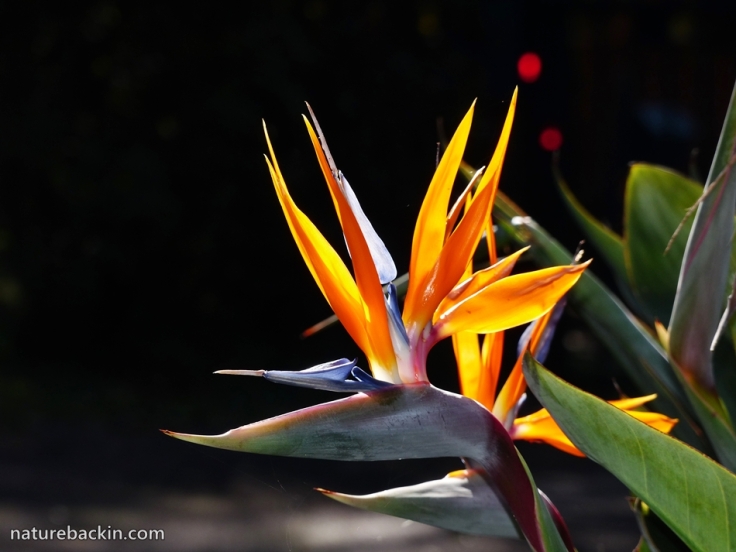
And also flowering in winter is the very showy Crane flower or Bird-of-paradise (Strelitzia reginae)
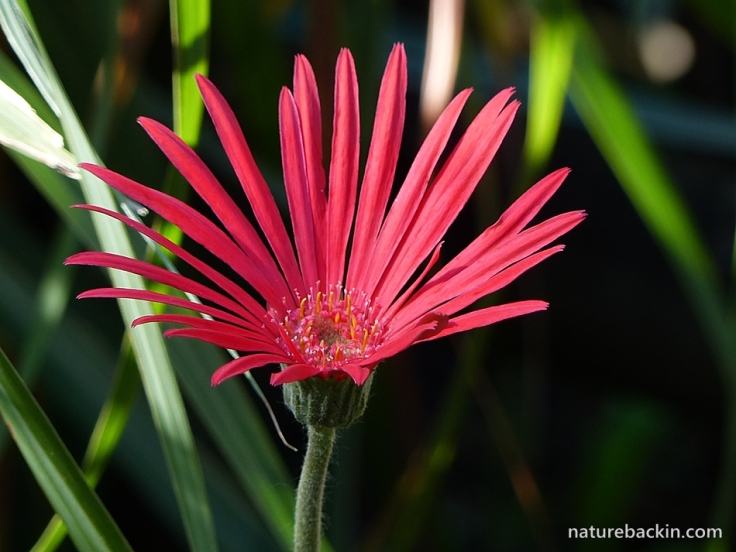
And to end, two hybrids of the indigenous Barbeton daisy (Gerbera jamesonii), daisies to warm any heart even in winter
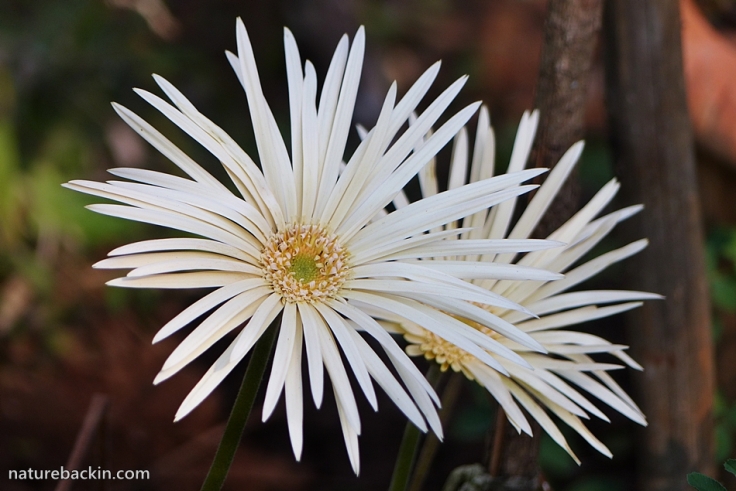
After a truly glorious sunny day today, the weather forecast is that very cold weather is on its way this weekend with unseasonable but very welcome rain on Saturday, and snow on the mountains. We might need more than cheerful flowers to keep us warm this weekend!
Posted by Carol

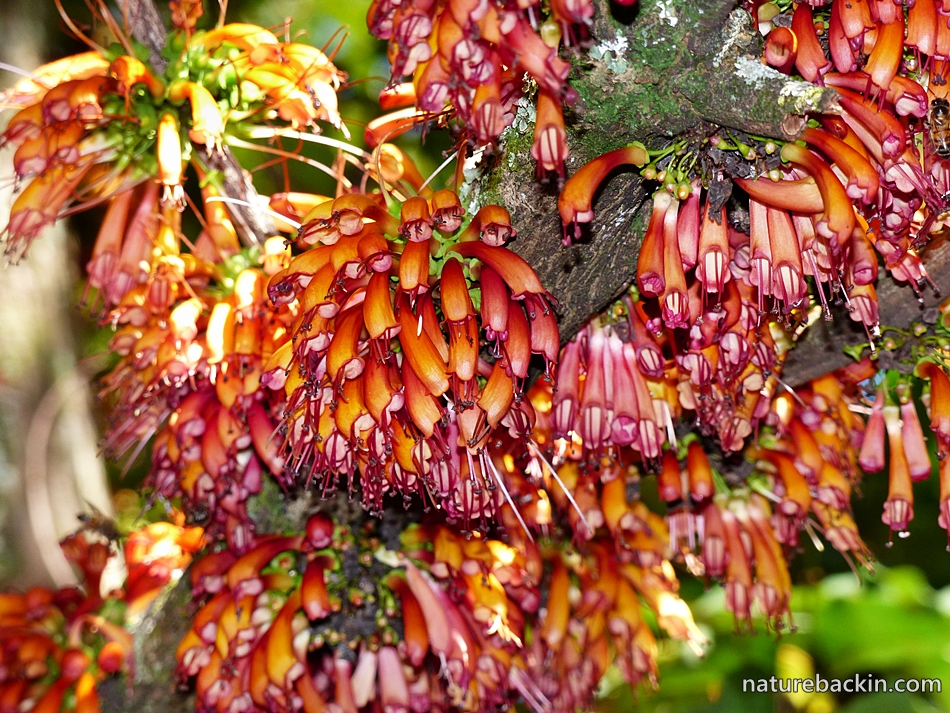







July 14, 2018 at 8:15 pm
Drab busters indeed. The tree fuschia is stunning.
LikeLiked by 1 person
July 15, 2018 at 8:29 pm
Yes it is 🙂
LikeLiked by 1 person
July 14, 2018 at 4:43 pm
Such vivid colour in Winter is quite alien to me. In Europe we crave the first brave blossoms of late winter – typically snowdrops and crocus before the daffodils sound the all clear and we know Spring is on the way. Here in Massachusetts, even though our latitude is the same as Madrid in Spain, I think we fair even worse. Your photos and your script have me hankering to see the corner of the world you bring us for myself. It is shiningly clear that you care deeply about your place and that too warms my heart.
LikeLiked by 1 person
July 15, 2018 at 8:26 pm
When I lived in the UK years back, I found the long period between winter and summer sooo long, too long to be referred to as spring! But the first flowers and flushes of new leaves certainly were most heartening as the days grew longer. Nowadays the seasons and weather are topsy turvy the world over. Would be nice if your hankering feelings lead into an actual visit 🙂
LikeLiked by 1 person
July 16, 2018 at 3:23 pm
My sister-out-law (the sister of my ex husband) lives in Botswana (she was previously in Zambia and before that South Africa) and I have absolutely promised I will visit. If I do that, it would be very silly not to spend some time in South Africa …
LikeLiked by 1 person
July 16, 2018 at 9:23 pm
We have visited only parts of Botswana, but quite a few times over the years and we love it. I hope you do get to visit your sister-out-law. And if you do then visiting SA too would be an excellent idea. And if you get to KwaZulu-Natal, our neck of the woods, that would be great.
LikeLiked by 1 person
July 13, 2018 at 6:29 am
We seem to have less colour in our winters. I can’t think of much, apart from berries and bark. What welcome splashes of warmth!
LikeLike
July 13, 2018 at 6:20 am
What a wonderful collection of winter flowers. It seems that you have lots of colour to carry you through the winter, like we do in Australia. I recently learned that flowering directly from the trunk of the tree like your tulip tree is called cauliflorescence which I think is a perfect word to describe that phenomenon.
LikeLiked by 1 person
July 13, 2018 at 11:11 am
What an interesting word. Thank you. It inspired me to look further and I was surprised to learn that despite its looks, the cauliflower that we eat is in fact not cauliflorous! However, it has been fascinating to see photos of how many plants are truly cauliflorous.
LikeLiked by 1 person
July 13, 2018 at 5:54 am
I love all the flowers you show, but the seedpod is a special delight for me! Very attractive!
LikeLiked by 1 person
July 13, 2018 at 10:48 am
Thanks Simone. I also like the seedpod. I am very fond of pods and seeds and I think they should be accorded more respect in the garden. In line with traditional gardening conventions they are routinely cut off in a process mysteriously called dead-heading, when in fact it is the seeds that are vehicles for new life!
LikeLiked by 1 person
July 13, 2018 at 5:07 pm
Dead-heading really sounds pretty brutal! So the most time I am very unconventionally in my garden, not only because seeds are incredibly photogenic…
LikeLiked by 1 person
July 13, 2018 at 3:58 am
How delightful for you and the birds and bees to have these great touches of color during your winter. I’m afraid our winter is quite drab compared to yours!
LikeLiked by 1 person
July 13, 2018 at 10:33 am
I am not sure how easily I would adapt to coping with your winters that are extreme compared to what I am used to!
LikeLike
July 14, 2018 at 10:13 am
Luckily the winters here on the coast aren’t as extreme as much of the rest of the country. We have relatively mild temperatures year round, but it’s two seasons: wet and dry. We just don’t seem to get as many flowers blooming as you’ve posted during winter. I’d have a hard time coping with either extreme heat or freezing weather, too.
LikeLiked by 1 person
July 13, 2018 at 3:22 am
I miss the Haleria lucida! It is interesting how the flowering times differ from one area to the next: our Leonotus leonurus as well as the Strelitzia are well past their prime, while the Haemanthus albiflos in our garden is still hanging on but looking a bit worn already. What a lovely collection of flowers you have out at the moment!
LikeLiked by 1 person
July 13, 2018 at 10:32 am
Yes it is quite an array. The different flowering times are interesting. We have noticed that the Leonotus in our region come into flower much earlier in the colder areas, which are likely to get frost in the winter, leading us to wonder if the cold triggers the flowering. The result is that the plants can get some good flowering done ahead of the frosts, whereas the later-flowering areas seldom get frost.
LikeLike
July 13, 2018 at 10:38 am
Interesting that.
LikeLiked by 1 person
July 13, 2018 at 12:19 am
Lots of beauty to tide you over the winter. Super photos!
LikeLiked by 1 person
July 13, 2018 at 10:21 am
Thanks Eliza. We are very lucky with our mild and sunny winters and the lovely plants that flower despite the dryness.
LikeLiked by 1 person
July 12, 2018 at 10:29 pm
O Carol your knowledge (not nowlegde 😁) is absolutely amazing. I assume you are a trained botanist. And yoor photos are excellent to boot
LikeLiked by 1 person
July 13, 2018 at 10:17 am
Thanks for the flattering comment Abri. However, I am one of those who knows a little about an eclectic array of interests. Probably dangerous? A friend of mine used to say that ‘generalists’ should be encouraged and worried about specialists and collectors residing in their silos, but I think we need both …
LikeLike
July 13, 2018 at 10:33 am
I am also a generalist regarding certain subjects but not to the the expired extent that you are
LikeLiked by 1 person
July 13, 2018 at 11:12 am
Which is why I am about to have a strong cup of coffee 🙂
LikeLike
July 12, 2018 at 9:56 pm
Some gorgeous flower shots!
LikeLiked by 1 person
July 13, 2018 at 10:11 am
Thanks so much Leya.
LikeLike